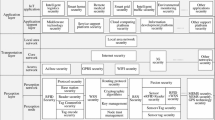Abstract
While media audiovisual programs have brought great convenience to people's study, work and life, there are also a lot of bad information flooding them. This research mainly discusses the design of media audio-visual program monitoring system based on network topology. The system mainly monitors audiovisual programs through the network topology scanning module. For security reasons, the system network structure is divided into two parts: internal network and external network. The supervisory system is located in the internal network and is physically separated from the external network. In the initial scanning process, first obtain the starting device information in the configuration file, which is the routing device by default, read the relevant information in the MIB through the SNMP agent, and analyze the neighboring routing device and its downstream switching devices and hosts. Information and other topological information, and transmit the topological information to the data organization and distribution module. In order to avoid a large load on the network operation of the target autonomous domain, it is recommended to scan a larger network once an hour, or you can make your own decision based on the actual situation. In order to be able to quickly and accurately discover the changes in scanned data, the system uses MD5 verification to generate a "fingerprint" for each record to identify the data. Through this algorithm, the amount of information in the database is effectively reduced, and the efficiency of retrieval is improved, and the system is optimized. In order to reduce the misjudgment of legal shadow marks in shadow marks, after verifying 10,000 sets of sample shadow mark images and adjusting the contrast recognition threshold, the missed judgement rate can be less than 2%. The system designed in this research meets the needs of program supervision.








Similar content being viewed by others
References
Back J, Kim JS (2017) Output feedback practical coordinated tracking of uncertain heterogeneous multi-agent systems under switching network topology. IEEE Trans Autom Control 62(12):6399–6406
Beaufort A, Curie F, Moatar F et al (2016) T-NET, a dynamic model for simulating daily stream temperature at the regional scale based on a network topology. Hydrol Process 30(13):2196–2210
Chan MY, Alhazmi FH, Park DC et al (2017) Resting-state network topology differentiates task signals across the adult life span. J Neuroence Off J Soc Neuroence 37(10):2734–2745
Chen GQ, Zhang X, Xing Y et al (2017) Resting-state functional magnetic resonance imaging shows altered brain network topology in Type 2 diabetic patients without cognitive impairment. Oncotarget 8(61):104560–104570
Chenhao W, Jimmy L, Fei HN et al (2017) Large-scale network topology reveals heterogeneity in individuals with at risk mental state for psychosis: findings from the longitudinal youth-at-risk study. Cereb Cortex 12:1–10
Damchi Y, Sadeh J, Mashhadi HR (2016) Preprocessing of distance and directional overcurrent relays coordination problem considering changes in network topology. Int Trans Electr Energy Syst 25(1):32–48
Du J, Zhao D, Zhang O (2019) Impacts of human communication network topology on group optimism bias in capital project planning: a human-subject experiment. Constr Manag Economics 37(1–3):44–60
Guo S, Lin J, Ren Y et al (2017) Study of network topology effect on measurement accuracy for a distributed rotary-laser measurement system. Opt eng 56(9):094101.1-094101.8
Han Y, Li H, Lang Y et al (2017) The effects of acute GABA treatment on the functional connectivity and network topology of cortical cultures. Neurochemi Res 42(5):1394–1402
Jiang W, Chen J, Tang H et al (2019) A physical probabilistic network model for distribution network topology recognition using smart meter data. IEEE Trans Smart Grid 10(6):6965–6973
Kohar V, Kia S, Kia B et al (2016) Role of network topology in noise reduction using coupled dynamics. Nonlinear Dyn 84(3):1805–1812
Liu Q, Van Wyk BJ, Du S et al (2016) Dynamic small world network topology for particle swarm optimization. Int J Pattern Recognit Artif Intell 30(9):47–97
Lu FM, Zhou JS, Zhang J et al (2017) Disrupted small-world brain network topology in pure conduct disorder. Oncotarget 8(39):65506–65524
Magoni D (2016) Network topology analysis and internet modelling with nem. Int J Comput Appl 27(4):252–259
Mascaraque N, Bauchy M, Smedskjaer MM (2017) Correlating the network topology of oxide glasses with their chemical durability. J Phys Chem B 121(5):1139–1147
Nedic A, Olshevsky A, Rabbat MG (2017) Network topology and communication-computation tradeoffs in decentralized optimization. Proc IEEE 106(5):953–976
Nystrom JK, Robbins MJ, Deckro RF (2018) Simulating attacker and defender strategies within a dynamic game on network topology. J simul 12(4):307–331
Ozkan-Canbolat E, Beraha A (2016) A configurational approach to network topology design for product innovation. J Bus Res 69(11):5216–5221
Qian F, Pan S et al (2016) Network topology tomography under multipath routing. IEEE Commun Lett: A Publication of the IEEE Communications Society 20(3):550–553
Somarakis C, Siami M, Motee N (2016) Interplays between systemic risk and network topology in consensus networks. IFAC-PapersOnLine 49(22):333–338
Wang Z, Wang Q, Moran B et al (2020) Optimal submarine cable path planning and trunk-and-branch tree network topology design. IEEE/ACM Trans Netw 28(4):1562–1572
Zhang W, Xu J, Li Y et al (2016) Detecting essential proteins based on network topology, gene expression data, and gene ontology information. IEEE/ACM Trans Comput Biol Bioinform 15(1):109–116
Zhang X, Han H, Zhang W (2017) Identification of boolean networks using premined network topology information. IEEE Trans Neural Netw Learn Syst 28(2):464–469
Zhong Z, Shimin L, Jianxue W (2017) Adaptability of active-power adjustment to voltage control considering network topology of microgrid. Dianli Zidonghua Sheb/Electric Power Automation Equipment 37(4):22–29
Zhu L, Zhao H (2017) Dynamical behaviours and control measures of rumour-spreading model with consideration of network topology. Int J Syst Sci 48(9–12):2064–2078
Author information
Authors and Affiliations
Corresponding author
Additional information
Publisher's Note
Springer Nature remains neutral with regard to jurisdictional claims in published maps and institutional affiliations.
Rights and permissions
About this article
Cite this article
Li, Z., Liu, S. Media audio-visual program supervision system based on network topology. Int J Syst Assur Eng Manag 12, 705–717 (2021). https://doi.org/10.1007/s13198-021-01066-2
Received:
Revised:
Accepted:
Published:
Issue Date:
DOI: https://doi.org/10.1007/s13198-021-01066-2




